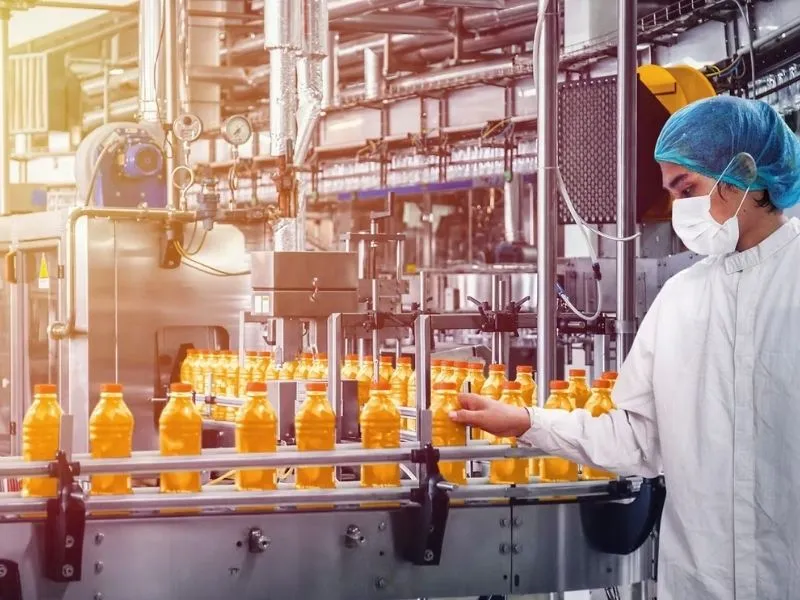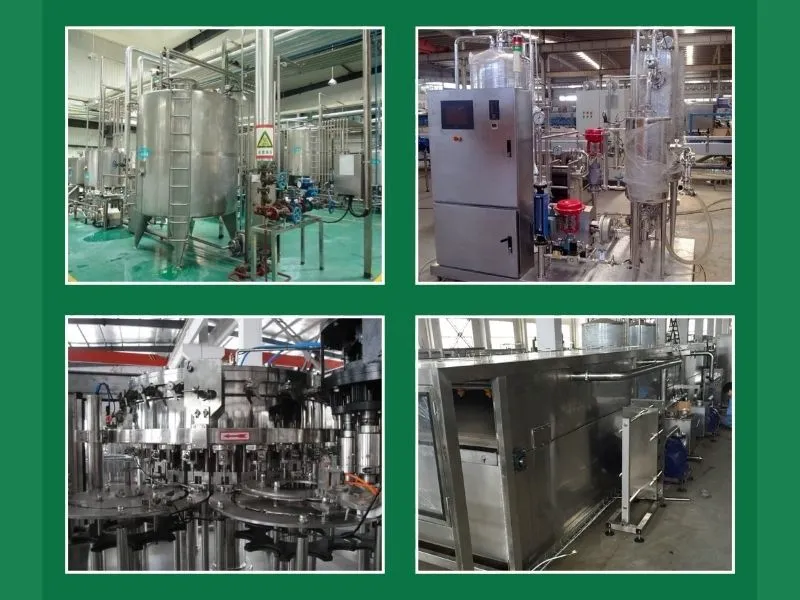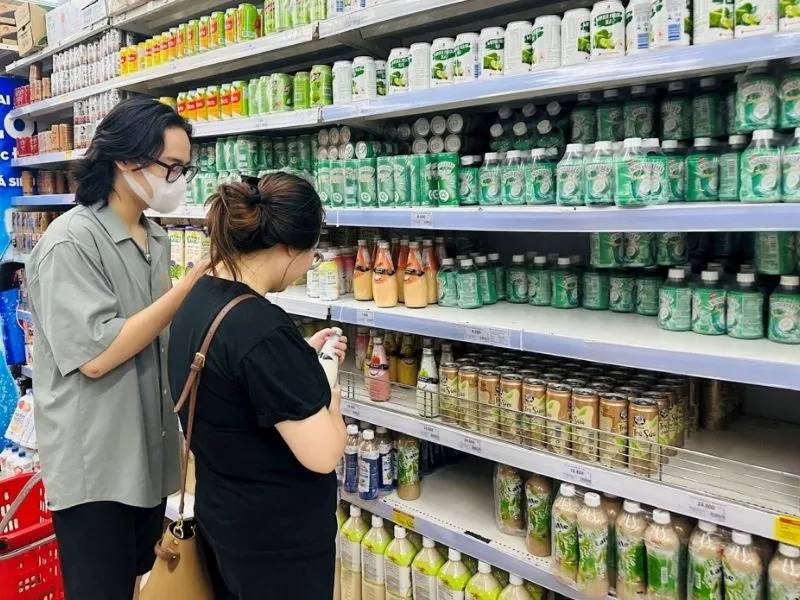Overview of bottled soft drink production line
14-08-2025 148
Carbonated soft drink production line is a system of equipment, machinery and technological processes designed to produce carbonated soft drinks.
Mục lục
The increasing demand for soft drinks means that businesses are investing heavily in modern machinery systems to optimize the production process, meeting the requirements of output and quality.
What is the definition of a soft drink production line?
A carbonated soft drink production line is a system of equipment, machinery and technological processes designed to produce carbonated soft drinks. This process includes many stages, from mixing syrup, mixing water with CO2 gas, filling into bottles/cans, to capping, labeling and packaging the finished product.
Carbonated soft drink production lines are often automated, helping to increase productivity, ensure consistent product quality and minimize human intervention in the production process.
Control systems such as PLCs (programmable logic controllers) and advanced technologies are used to regulate factors such as pressure, temperature and mixing ratio, to ensure that carbonated soft drinks meet the requirements of taste, effervescence and hygiene quality.
According to a report by the Ministry of Industry and Trade, the current soft drink consumption of Vietnamese people is only 23 liters per year on average, much lower than the 40 liters per year of global consumers. This shows that the soft drink market in Vietnam still has great potential for development.
Ms. Louise Hawley, Managing Director of Nielsen Vietnam Market Research Company, said that Vietnam has a young population, with more than 62.2% of people aged 15 to 54, creating a large demand for soft drink products.
In 2023, revenue from the Vietnamese beverage industry reached 8.25 billion USD and is forecast to exceed 10 billion USD by 2027. With the strong growth prospects of this market, many international enterprises have been actively investing in production lines.

Structure and main machinery of the soft drink production line
- Water treatment system
The input water treatment stage is the first step in the soft drink production line. Water source exploited from the water supply system or well will be filtered through filters capable of removing impurities, microorganisms and heavy metals.
Commonly used treatment technologies include:
- Rough filtration system: Removes large dirt particles.
- Activated carbon filter: Removes odors and chemical compounds.
- UV or ozone sterilizer: Kills bacteria, ensuring water meets safety standards.
After going through the treatment system, the water meets the cleanliness standards and is ready to be used in the next stages.
- Mixing system
The mixing system plays a role in creating a consistent flavor for the soft drink product. In this stage, the main ingredients such as sugar, flavoring, water and CO2 gas are mixed in precise proportions.
- Important equipment includes:
- Mixing tank: Mixing liquid ingredients.
- Carbonation equipment: Adding CO2 to create gas for soft drinks.
Automatic control system: Helps ensure the mixing ratio is correct according to the formula.
The main goal is to ensure consistent flavor in each batch of product, bringing the best experience to consumers.
- Filling and bottling machine
After completing the mixing process, the soft drink is transferred to the filling and bottling system. This is a stage that requires high precision and is fully automated.
The main equipment includes:
- Filling machine: Transfers soft drinks into bottles quickly and aseptically.
- Capping machine: Automatically caps bottles, ensuring tightness.
- Packaging line: Completes the process by using labels, closing cartons.
Commonly used packaging includes PET bottles, aluminum cans or glass bottles. The process is designed to optimize production speed and ensure quality.
- Product labeling and packaging system
After completing the filling process, the products are transferred to the automatic labeling step. Thanks to modern label printers, the product labels are beautifully designed and sturdy. The next packaging process ensures that the products reach consumers intact.
- Quality control system
Before the product is released to the market, the quality control system will evaluate criteria such as the tightness of the bottle/can, taste, and hygiene safety. Laser scanners and automatic equipment ensure that the products meet the standards before final packaging.
Example of carbonated soft drink production line
- Syrup dispensing system
Syrup is a very important ingredient in carbonated drinks, so to produce high-quality syrup, the following steps are required:
- First, select high-quality, natural pure sugar.
- Second, strictly control the syrup production technology process. During the sugar dissolution process, stir well in the sugar dissolution tank while adding sugar, then use 50-55°C hot water to dissolve the sugar until the concentration of dissolved solids in the syrup reaches 45-65 Brix. Then we will get syrup.
- Next, use a double filter to remove impurities in the sugar solution. Use a plate or tube sterilizer to sterilize the syrup by heat treatment at 90-95°C.
- Finally, we will have high-quality syrup for use in beverage production.

- Carbonation Mixer
The CO2 mixer is responsible for mixing carbon dioxide and water. Before CO2 is fed into the mixing tank, a potassium permanganate tower and an activated carbon tower will be used to remove organic impurities and other impurities in the CO2 gas.
The mixing process is as follows:
- Pure CO2 is mixed with 4°C cold water at low temperature.
- Then, the carbonated water will be mixed with syrup (cooled by a plate heat exchanger) in a static mixing tank.
- The final result is a complete carbonated drink.
The mixing system includes: deoxidizer tank, syrup tank, liquid level gauge, static mixing storage tank, electronic control system, gas supply box, piping system and valve. All are made of high quality 304 stainless steel, with polished internal and external surfaces, meeting international food hygiene standards.
- The system operates fully automatically, with a built-in alarm system.
- The pressure and liquid level are automatically adjusted, the whole production process is controlled by PLC. If an error occurs, the system will alarm and automatically stop working.
- The mixture is evenly mixed and reaches the standard ratio, using advanced static mixing technology to mix water and CO2. This process is controlled by a fine-tuning needle valve with a mixing accuracy of about 5‰.
- Carbonated drink filling machine
The carbonated drink filling machine is also known as an isobaric filling machine. The isobaric filling valve does not directly affect the liquid, thus minimizing the loss of CO2. The machine is suitable for filling carbonated beverages such as carbonated drinks, beer, sparkling wine and other beverages containing CO2 with a filling pressure below 0.5MPa.
- Carbonated beverage bottle/can warmer
Because carbonated drinks are cold-filled at 3-5°C, after filling, it is necessary to use a spray-type heating conveyor to bring the beverage temperature to room temperature in preparation for the packaging process (shrink-wrapping or cartoning).
The bottle warmer uses hot water to spray onto the surface of the bottle or can, increasing the beverage temperature to about 30-35°C.

Benefits of using a soft drink production line
- Increase productivity: Automating the production line helps production to be fast, stable and meet the needs of large output.
- Save costs: Reduce labor costs thanks to the automatic system and efficient operation.
- Consistent quality: Ensure products meet standards, consistent in flavor, sweetness and quality.
- Ensure hygiene and safety: The production system is made of stainless steel and complies with international food hygiene standards.
- Easy to control: The production process is controlled by PLC, automatically adjusted and has a warning system when incidents occur.
- Environmental protection: Limit waste of raw materials and reduce emissions thanks to the optimal production process.
- Product diversity: Flexibly produce many different types of soft drinks, from carbonated to non-carbonated, suitable for market needs.
The Role of Conveyor Systems in Soft Drink Production Lines
Conveyor systems play an important role in transporting raw materials, empty bottles/cans and finished products through different stages of the production line. This helps ensure continuous production, minimizes interruptions and optimizes the productivity of the factory.
In addition, conveyors help reduce dependence on manual labor by automating transportation. This not only saves labor costs but also limits human errors. At the same time, the conveyor system also protects the product, reducing the risk of breakage or scratches, especially with fragile products such as glass bottles.
This system also ensures synchronization between stages in the production line such as filling, capping, labeling and packaging. Thanks to that, the steps in the process are closely connected, operating smoothly and efficiently.
In addition, conveyor belts help save time by shortening the process of moving products between stages, thereby increasing production speed. With a flexible design, the conveyor system can be adjusted to suit each type of product and specific production needs.
In summary
Thus, investing in a bottled soft drink production line not only helps businesses increase productivity, reduce production costs but also ensures consistent product quality, meeting the increasing needs of consumers.
With outstanding benefits in efficiency and automation, industrial production lines will be the decisive factor in helping companies maintain competitiveness and sustainable development in the increasingly fierce beverage market.


